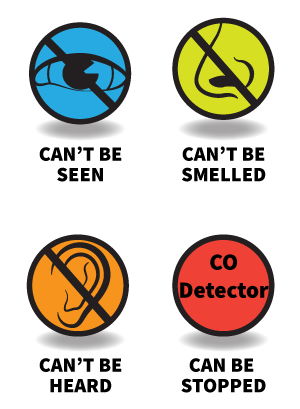by:Phil Hatfield, CSP, MS

Carbon Monoxide
Each year, several thousands of American workers are killed from carbon monoxide exposure, making the poisonous gas one of the most dangerous and widespread industrial hazards. Carbon monoxide causes more deaths than any other toxic agent except alcohol.
The primary danger of carbon monoxide is that it cannot be easily detected. Carbon monoxide is a colorless, odorless, tasteless gas, and thus gives its victims no advance warning. When mixed with air, large quantities of carbon monoxide can be highly flammable and explosive, although situations resulting in such high concentrations are rare.
The OSHA Standard
The current standard set by the Occupational Safety and Health Administration (OSHA) limits exposure to a permissible exposure limit, or PEL, of 50 parts per million (ppm) or 55 mg/m3 over an 8-hour period. The ACGIH has a threshold limit value, or TLV-TWA, of 50 ppm with a TLV-STEL of 400 ppm. NIOSH (1973d/Ex. 1-237) recommends an 8-hour TWA limit of 35 ppm with a 200 ppm ceiling. General Industry
In general industry, the internal combustion engine is the chief source of workplace exposure to carbon monoxide. Many furnaces and ovens also produce large amounts of the gas, especially when they are not properly maintained. Truck drivers, forklift operators, or anyone working near such equipment can be potentially exposed. Persons working near or within enclosed areas such as manholes, garages, tunnels, loading docks, warehouses, and vehicle repair shops are particularly in danger of exposure to carbon monoxide.
Construction
In the construction field, exposure to carbon monoxide can occur by welding units, indoor propane (or other organic gas) heaters, forklifts, and other gas-powered vehicles. The combination of these types of gas-generating vehicles and equipment with reduced airflow can lead to the build-up of carbon monoxide. Ventilation is reduced by erecting temporary plastic walls and rooms, installing temporary doors, and by other natural processes involved in completing a construction project. Because construction projects change so quickly, time and thought must be given to ensure that carbon monoxide is not being generated in harmful levels while the project is naturally evolving.
Health Effects
Carbon monoxide enters the bloodstream through the lungs and combines with hemoglobin. This means that even though there may be ample oxygen in the surrounding atmosphere, carbon monoxide will get into the bloodstream first. High blood-level concentrations of the compound will prevent enough oxygen from reaching the heart and brain. This can lead to suffocation, capillary hemorrhaging, permanent damage of nerve tissues and brain cells, and, possibly, death.
Symptoms of carbon monoxide poisoning are headaches, dizziness, drowsiness, or nausea. More long-term exposure can lead to rapid pulse, confusion, loss of coordination, or collapse. Finally, high exposure can lead to convulsions, coma, or death.
What Can be Done to Protect Workers?
First and foremost, control and/or reduce the amount of equipment that produces carbon monoxide. The following steps can be taken to reduce exposure to carbon monoxide:
- Work involving welding can be done outside or in well-ventilated areas.
- Reduce the number of gas-powered vehicles used inside of a building or structure.
- Ensure that gas-powered equipment is properly maintained to verify that carbon monoxide is not generated in excessive levels.
- Ventilation can be managed to ensure that an adequate amount of fresh air is being provided to workers.
- Ensure that your work area is not getting carbon monoxide exposure from other locations or sources.
- Monitor the air with a carbon monoxide monitor, four gas meter, or other similar type of air monitoring device. These devices can provide an instantaneous result that allows you to make quick and informed decisions on how to protect workers.
Managing carbon monoxide in the workplace will increase the safety of all employees. Training employees to the dangers of carbon monoxide will also increase the efforts towards reducing exposure to this harmful gas. Being more informed and using air monitoring tools can greatly reduce the chances of exposure to carbon monoxide.

